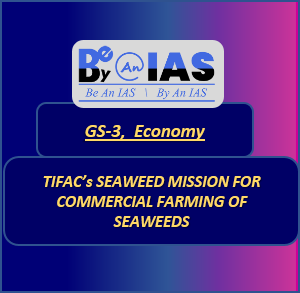CURRENT AFFAIRS
Get the most updated and recent current affair content on Padhaikaro.com
TIFAC’s SEAWEED MISSION FOR COMMERCIAL FARMING OF SEAWEEDS
- Be N By IAS, Delhi
- 11, Feb 2021

For : GS-3: Economy, Agriculture
CONTEXT:
- Recently Technology Information, Forecasting and Assessment Council (TIFAC) launched Seaweed Mission for commercial farming of seaweeds and its processing for value addition towards boosting national economy.
- It was launched on the occasion of the 34th Foundation Day celebrations yesterday.

SEAWEED MISSION:
- Why: Out of the global seaweed production of ~ 32 million tons fresh weight valued around 12 billion US dollars.
- China produces ~57 %,
- Indonesia ~28%
- India ~0.01-0.02%.
- South-East Asian countries: Despite several advantages, commercial seaweeds cultivation has not been taken place in the country at an appropriate scale, as being practiced in South-East Asian countries.
- The Mission envisages the following activities:
- Establishing model demonstration farms over one hectare for cultivation of economically important seaweeds in nearshore and onshore along the Indian coast
- Kappaphycus all over Indian coast
- Gracilaria dura in Gujarat
- Gracilariaverrucosa in Chilka lake (Odhisa)
- Ulva linza or Ulva proliferainChilka lake (Odhisa)
- Ulva lactuca or Ulva fasciata or Ulva indica all over India coast
- Proposed Demonstration Sites: Gujarat / Tamil Nadu / Andhara Pradesh / Odisha / Karnataka
SIGNIFICANCE:
By an estimate, if cultivation is done in ≈10 million hectares or 5% of the EEZ area of India, it will lead to:
Employment to ~ 50 million people;
- Set up new seaweed industry;
- Contribute to national gdp;
- Ocean productivity;
- Abates algal blooms,
- Sequesters millions of tons co2;
- Healthier ocean;
- Bio-ethanol of 6.6 billion litres
TECHNOLOGY INFORMATION, FORECASTING AND ASSESSMENT COUNCIL (TIFAC):
- TIFAC is an autonomous organization set up in 1988 under the Department of Science & Technology.
- As per the recommendation of Technology Policy Implementation Committee (TPIC) in 1985, Cabinet approved the formation of TIFAC in mid-1986.
- It was formed as a registered Society in February, 1988 under the Department of Science and Technology as an autonomous body.
- It was mandated to assess the state-of-art of technology and set directions for future technological development in India in important socio-economic sectors.

SOURCE: PIB
MCQs:
Q. Which of the following will take place if Seaweed production increases in India?
- Decreases Ocean productivity
- Abates algal blooms
- Sequesters millions of tons Co2
- Healthier ocean
Select the correct answer using the code below.
- a) 1 and 2 Only
- b) 2 and 3 Only
- c) 2, 3 and 4 Only
- d) 1, 2, 3 and 4
ANS: C